| Emperor Bảo Đại 保大帝 | |||||
|---|---|---|---|---|---|
.jpg.webp) The Emperor on his throne, c. 1920s-30s | |||||
| Emperor of An Nam and Empire of Vietnam | |||||
| Reign | 8 January 1926 – 30 August 1945 | ||||
| Predecessor | Khải Định | ||||
| Successor | Monarchy abolished Hồ Chí Minh (as president of the Democratic Republic of Vietnam) | ||||
| Chief of State of Vietnam | |||||
| Reign | 13 June 1949 – 26 October 1955 | ||||
| Predecessor | Position established Nguyễn Văn Xuân (as Head of the Provisional Central Government) | ||||
| Successor | Position abolished Ngô Đình Diệm (as president of the Republic of Vietnam) | ||||
| 1st Prime Minister of the State of Vietnam | |||||
| Reign | 14 July 1949 – 21 January 1950 | ||||
| Predecessor | Position established | ||||
| Successor | Nguyễn Phan Long | ||||
| Supreme Advisor to the Government of the Democratic Republic of Vietnam | |||||
| Reign | 10 September 1945 – 16 March 1946 | ||||
| Predecessor | Position established | ||||
| Successor | Position abolished | ||||
| Born | Nguyễn Phúc Vĩnh Thụy (阮福永瑞) 22 October 1913 Doan-Trang-Vien Palace, Imperial City of Huế, French Indochina | ||||
| Died | 31 July 1997 (aged 83) Val-de-Grâce, Paris, France | ||||
| Burial | |||||
| Spouse |
Bùi Mộng Điệp Lê Thị Phi Ánh Christiane Bloch-Carcenac | ||||
| Issue | See List
| ||||
| |||||
| House | Nguyễn Phúc | ||||
| Father | Khải Định | ||||
| Mother | Hoàng Thị Cúc | ||||
| Religion | Confucianism Mahayana Buddhism Roman Catholicism | ||||
| Signature | |||||
Bảo Đại (Vietnamese: [ɓa᷉ːw ɗâːjˀ], chữ Hán: 保大, lit. "keeper of greatness", 22 October 1913 – 31 July 1997),[2] born Nguyễn Phúc/Phước Vĩnh Thụy (chữ Hán: 阮福永瑞), was the 13th and final emperor of the Nguyễn dynasty, the last ruling dynasty of Vietnam.[3] From 1926 to 1945, he was emperor of Annam and de jure monarch of Tonkin, which were then protectorates in French Indochina, covering the present-day central and northern Vietnam. Bảo Đại ascended the throne in 1932.
The Japanese ousted the Provisional French administration in March 1945 and then ruled through Bảo Đại, who proclaimed the Empire of Vietnam. He abdicated in August 1945 when Japan surrendered. From 1949 to 1955, Bảo Đại was the chief of state of the non-communist State of Vietnam. Viewed as a puppet ruler, Bảo Đại was criticized for being too closely associated with France and spending much of his time outside Vietnam. He was eventually ousted in a referendum in 1955 by Prime Minister Ngô Đình Diệm, who was supported by the United States.
Early life
Bảo Đại was born on 22 October 1913 and given the name of Prince Nguyễn Phúc Vĩnh Thụy in the Palace of Doan-Trang-Vien, part of the compound of the Purple Forbidden City in Huế, the capital of Vietnam. He was later given the name Nguyễn Vĩnh Thụy. His father was Emperor Khải Định of Annam. His mother was the emperor's second wife, Tu Cung, who was renamed 'Doan Huy' upon her marriage. She held various titles over the years that indicated her advancing rank as a favored consort until she eventually became Empress Dowager in 1933. Vietnam had been ruled from Huế by the Nguyễn dynasty since 1802. The French government, which took control of the region in the late 19th century, split Vietnam into three areas: the protectorates of Annam and Tonkin and the colony of Cochinchina. The Nguyễn dynasty was given nominal rule of Annam.
At the age of nine, Prince Nguyễn Phúc Vĩnh Thụy was sent to France to study at the Lycée Condorcet and, later, the Paris Institute of Political Studies. He became emperor on 8 January 1926, after his father's death, and took the era name Bảo Đại ("Protector of Grandeur" or "Keeper of Greatness").[4][5] He did not yet ascend to the throne and returned to France to continue his studies.[5]
 Young crown prince Vĩnh Thụy.
Young crown prince Vĩnh Thụy. Crown Prince Vĩnh Thụy in 1920
Crown Prince Vĩnh Thụy in 1920 Young prince Vinh Thuy (2nd right to left).
Young prince Vinh Thuy (2nd right to left). Young emperor
Young emperor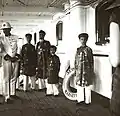 Young crown prince Vĩnh Thụy (right) boarding the Azay-le-Rideau steamer bound for Marseille, to study in France,1922.
Young crown prince Vĩnh Thụy (right) boarding the Azay-le-Rideau steamer bound for Marseille, to study in France,1922.Agence_de_btv1b9025201h_1.jpg.webp) Crown prince Vĩnh Thụy (right) and his cousin Vĩnh Cẩn in Paris (1926) during studying abroad in France
Crown prince Vĩnh Thụy (right) and his cousin Vĩnh Cẩn in Paris (1926) during studying abroad in France Bảo Đại in Paris, 1926
Bảo Đại in Paris, 1926 Emperor Bảo Đại.
Emperor Bảo Đại. Portrait of Bảo Đại period 1952–1954.
Portrait of Bảo Đại period 1952–1954.
Marriages
On 20 March 1934, age 20, at the imperial city of Huế, Bảo Đại married Marie-Thérèse Nguyễn Hữu Thị Lan (died 15 September 1963, Chabrignac, France), a commoner from a wealthy Vietnamese Catholic family. After the wedding, she was given the title Empress Nam Phương. The couple had five children: Crown Prince Bảo Long (4 January 1936 – 28 July 2007), Princess Phương Mai (1 August 1937 – 16 January 2021), Princess Phương Liên (born 3 November 1938), Princess Phương Dung (born 5 February 1942), and Prince Bảo Thắng (9 December 1943 – 15 March 2017). Although Bảo Đại later had additional children with other women, these are the only ones listed in the clan genealogy.[1]
Mistresses
 Concubine Phi Ánh
Concubine Phi Ánh Concubine Mộng Điệp
Concubine Mộng Điệp Bao Dai and Mộng Điệp
Bao Dai and Mộng Điệp
Nam Phương was granted the title of empress in 1945. By one count, Bảo Đại had relationships with eight women and fathered 13 children. Those named "Phương" are daughters, while those named "Bảo" are sons.[6]
| Name | Title | Issue | Note |
|---|---|---|---|
| Nguyễn Hữu Thị Lan | Empress Nam Phương |
Crown Prince Bảo Long (1936–2007)
Princess Phương Mai (1937–2021) Princess Phương Liên (b. 1938) Princess Phương Dung (b. 1942) Prince Bảo Thắng (1943–2017) |
The emperor's first wife. "Nam Phương" translates as "Southern virtue". |
| Bùi Mộng Điệp | Thứ phi | Phương Thảo (b. 1946)
Bảo Hoàng (1954–1955) Bảo Sơn (1957–1987) |
Called thứ phi phương Bắc ("Northern secondary consort"). |
| Lý Lệ Hà | Mistress | Won Vietnam's first beauty contest in 1938 in Hà Đông. She publicly dated Bảo Đại in Hanoi in 1946. The couple later lived together in Hong Kong, according to her account.[7] | |
| Variously called Huang Xiaolan, Hoàng Tiểu Lan, Jenny Woong, and Trần Nỷ | Mistress | Phương An | Mixed Chinese-Vietnamese Hong Kong actress who had an affair with Bảo Đại 1946 when he was in Hong Kong.[6] |
| Lê Thị Phi Ánh | Thứ phi | Phương Minh (1949–2012)
Bảo Ân (b. 1953) |
Sister-in-law of Prime Minister Phan Văn Giáo |
| Vicky | Mistress | Phương Từ (1955) | This daughter by a French woman has "a half European Asian beauty."[6] |
| Christiane Bloch-Carcenac | Mistress | Patrick-Édouard Bloch-Carcenac (b. 1958) | Affair occurred in 1957–1970 |
| Monique Baudot | Imperial princess
Self-styled Empress Thái Phương |
Second wife. She was a French citizen whom Bảo Đại married in 1972. |
Independence and abdication
In 1940, during the second World War, coinciding with their ally Nazi Germany's invasion of France, Imperial Japan took over French Indochina. While they did not eject the French colonial administration, the occupation authorities directed policy from behind the scenes in a parallel of Vichy France. The Japanese promised not to interfere with the court at Huế, but in 1945, after ousting the French, coerced Bảo Đại into declaring Vietnamese independence from France as a member of Japan's "Greater East Asia Co-Prosperity Sphere"; the country then became the Empire of Vietnam.
Bảo Đại, however, appeared to believe that independence was an irreversible course. In 1944, he wrote to General de Gaulle, leader of the Free French:
You have suffered too much during four deadly years, not to understand that the Vietnamese people, who have a history of twenty centuries and an often glorious past, no longer wish, no longer can support any foreign domination or foreign administration...You could understand even better if you were able to see what is happening here, if you were able to sense the desire for independence that has been smoldering in the bottom of all hearts and which no human force can any longer hold back. Even if you were to arrive to re-establish a French administration here, it would no longer be obeyed; each village would be a nest of resistance. every former friend an enemy, and your officials and colonials themselves would ask to depart from this unbreathable atmosphere.[8]
The Japanese had a Vietnamese pretender, Prince Cường Để, waiting to take power in case the new emperor's "elimination" was required. Japan surrendered to the Allies in August 1945, and the Viet Minh (under the leadership of communist Hồ Chí Minh) aimed to take power in a free Vietnam. Due to his popular political stand against the French and the 1945 famine, Hồ was able to persuade Bảo Đại to abdicate on 25 August 1945, handing power over to the Việt Minh – an event which greatly enhanced Hồ's legitimacy in the eyes of the Vietnamese people.[9] Bảo Đại was appointed the "supreme advisor" to Hồ's Democratic Republic of Vietnam (DRV) in Hanoi, which proclaimed its independence on 2 September 1945. The DRV was then ousted by the newly formed French Fourth Republic in November 1946.[10]
 Declaration of Empire of Vietnam in 1945
Declaration of Empire of Vietnam in 1945.jpg.webp) Abdication ceremony of Bảo Đại.
Abdication ceremony of Bảo Đại. The National assembly of the Democratic Republic of Vietnam on 2 March 1946, supreme advisor Vĩnh Thụy (Bảo Đại), sixth from right to left, next to President Hồ Chí Minh (middle).
The National assembly of the Democratic Republic of Vietnam on 2 March 1946, supreme advisor Vĩnh Thụy (Bảo Đại), sixth from right to left, next to President Hồ Chí Minh (middle). Bảo Đại (right) as the "supreme advisor" to the government of the Democratic Republic of Vietnam led by president Hồ Chí Minh (left), 1 June 1946
Bảo Đại (right) as the "supreme advisor" to the government of the Democratic Republic of Vietnam led by president Hồ Chí Minh (left), 1 June 1946 Members of national assembly of Democratic Republic of Vietnam, Bảo Đại (far right).
Members of national assembly of Democratic Republic of Vietnam, Bảo Đại (far right).
.svg.png.webp)
Cabinet
 Tôn Thất Đàn, head of Minister of Justice from 1927 to 1933
Tôn Thất Đàn, head of Minister of Justice from 1927 to 1933 Hồ Đắc Khải (left) Minister of Revenue from 1933 to 1945 and Thái Văn Toản (middle), minister of Justice in 1933–1942.
Hồ Đắc Khải (left) Minister of Revenue from 1933 to 1945 and Thái Văn Toản (middle), minister of Justice in 1933–1942.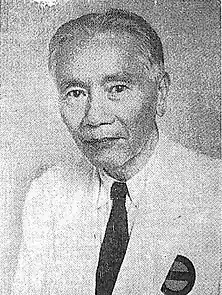 Trần Trọng Kim, Prime Minister of Empire of Vietnam
Trần Trọng Kim, Prime Minister of Empire of Vietnam
Return to power and Indochina War
Bảo Đại spent nearly a year as "supreme advisor" to the DRV, during which period Vietnam descended into armed conflict between rival Vietnamese factions and the French. He left this post in 1946 and moved to Hong Kong, where the French and Việt Minh both attempted unsuccessfully to solicit him for political support.[11]
.jpg.webp)
Eventually a coalition of Vietnamese anti-communists (including future South Vietnamese leader Ngô Đình Diệm and members of political/religious groups such as the Cao Dai, Hòa Hảo, and VNQDĐ) formed a National Union and declared to support Bảo Đại on the condition he would seek independence for Vietnam. This persuaded him to reject Việt Minh overtures and enter into negotiations with the French. On 7 December 1947, Bảo Đại signed the first of the Ha Long Bay Agreements with France. Despite ostensibly committing France to Vietnamese independence, it was considered minimally binding and transferred no actual authority to Vietnam. The agreement was promptly criticized by National Union members, including Diệm. In a possible attempt to escape the resulting political tension, Bảo Đại travelled to Europe and commenced on a four-month pleasure tour which earned him the sobriquet "night club emperor". After persistent efforts by the French, Bảo Đại was persuaded to return from Europe and sign a second Ha Long Bay Agreement on 5 June 1948. This contained similarly weak promises for Vietnamese independence and had as little success as the first agreement. Bảo Đại once again travelled to Europe whilst warfare in Vietnam continued to escalate.[11]
After months of negotiations with French President Vincent Auriol, he finally signed the Élysée Accords on 9 March 1949, which led to the establishment of the State of Vietnam with Bảo Đại as Chief of State (國長, Quốc trưởng); the French also oversaw the creation of the Domain of the Crown where he was still officially considered to be the Emperor, this territory existed until 1955.[11]
However, the country was still only partially autonomous, with France initially retaining effective control of the army and foreign relations. Bảo Đại himself stated in 1950: "What they call a Bảo Đại solution turned out to be just a French solution... the situation in Indochina is getting worse every day".[11]
As Diệm and other hardcore nationalists were disappointed in the lack of autonomy and refused high government posts, Bảo Đại mainly filled his government with wealthy figures strongly connected to France. He then spent his own time in the resort towns of Da Lat, Nha Trang, and Buôn Ma Thuột, largely avoiding the process of governing. All this contributed to his reputation as a French puppet and a rise in popular support for the Việt Minh, whose armed insurgency against the French-backed regime was developing into a full-fledged civil war. Nonetheless, in 1950 he attended a series of conferences in Pau, France where he pressed the French for further independence. The French granted some minor concessions to the Vietnamese, which caused a mixed reaction on both sides.[11]
In addition to the increasing unpopularity of the Bảo Đại government, the communist victory in China in 1949 also led to a further revival of the fortunes of the Việt Minh. When China and the Soviet Union recognized the DRV government, the United States reacted by extending diplomatic recognition to Bảo Đại's government in March 1950. This and the outbreak of the Korean War in June led to U.S. military aid and active support of the French war effort in Indochina, now seen as anti-communist rather than colonialist. Despite this, the war between the French colonial forces and the Việt Minh started to go badly for the French, culminating in a major victory for the Việt Minh at Điện Biên Phủ. This led to the negotiating of a 1954 peace deal between the French and the Việt Minh, known as the Geneva Accords, which partitioned Vietnam at the 17th parallel. The north side was given to the DRV, with the State of Vietnam receiving the south. Bảo Đại remained "Head of State" of South Vietnam, but moved to Paris and appointed Ngô Đình Diệm as his prime minister.[11][12]
Second removal from power
At first, Ngô Đình Diệm exercised no influence over South Vietnam: the Việt Minh still had de facto control of somewhere between sixty and ninety percent of the countryside (by French estimates), whilst the rest was dominated by the various religious sects. Meanwhile, the new capital of Saigon was under the total control of criminal group Bình Xuyên. According to Colonel Lansdale, it had paid Bảo Đại a "staggering sum" for control of local prostitution and gambling and of Saigon's police force.[11]
Regardless, Diệm's forces embarked on a campaign against the Bình Xuyên, with fighting breaking out in the streets on 29 March 1955. In an attempt to protect his clients, Bảo Đại ordered Diệm to travel to France, but he was disobeyed and Diệm eventually succeeded in pushing his opponents out of the city. Using a divide and conquer strategy, Diệm then employed a mixture of force and bribery to sway the remaining religious sects to his side.[11]
 Anti-Bao Dai's pro-french regime in State of Vietnam national assembly, Saigon, 1955
Anti-Bao Dai's pro-french regime in State of Vietnam national assembly, Saigon, 1955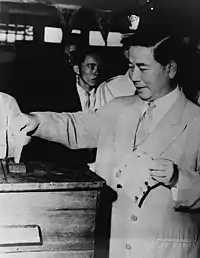 Prime minister Ngo Dinh Diem voting to overthrow chief-of-state Bảo Đại
Prime minister Ngo Dinh Diem voting to overthrow chief-of-state Bảo Đại The result of the 1955 referendum, Saigon
The result of the 1955 referendum, Saigon
Now with a broad range of support, a new Popular Revolutionary Committee (formed by Diệm's brother Ngô Đình Nhu) was able to call for a referendum to remove Bảo Đại and establish a republic with Diệm as president.[11] The campaign leading up to the referendum was punctuated by personal attacks against the former emperor, whose supporters had no way to refute them since campaigning for Bảo Đại was forbidden.[13]
The 23 October referendum was criticized as being fraudulent. The official results showed a tally of 98.9% in favor of a republic, with the number of votes for a republic exceeding the total number of registered voters by 155,025 in Saigon, while the total number of votes exceeded the total number of registered voters by 449,084, and the number of votes for a republic exceeded the total number of registered voters by 386,067.[13]
Bảo Đại was removed from power, with Diệm declaring himself president of the new Republic of Vietnam on 26 October 1955.
Life in exile
In 1957, during his visit to Alsace region, he met Christiane Bloch-Carcenac with whom he had an affair for several years. The relationship with Bloch-Carcenac resulted in the birth of his last child, Patrick-Édouard Bloch-Carcenac, who still lives in Alsace in France.[14][15]
In 1972, Bảo Đại issued a public statement from exile, appealing to the Vietnamese people for national reconciliation, stating, "The time has come to put an end to the fratricidal war and to recover at last peace and accord".[2] At times, Bảo Đại maintained residence in southern France, and in particular, in Monaco, where he sailed often on his private yacht, one of the largest in Monte Carlo harbor. He still reportedly held great influence among local political figures in the Quảng Trị and Thừa Thiên provinces of Huế. The Communist government of North Vietnam sent representatives to France hoping that Bảo Đại would become a member of a coalition government which might reunite Vietnam, in the hope of attracting his supporters in the regions wherein he still held influence.
As a result of these meetings, Bảo Đại publicly spoke out against the presence of American troops in South Vietnam, and he criticized President Nguyễn Văn Thiệu's regime in South Vietnam. He called for all political factions to create a free, neutral, peace-loving government which would resolve the tense situation that had taken form in the country.
In 1982, Bảo Đại, his wife Monique, and other members of the former imperial family of Vietnam visited the United States. His agenda was to oversee and bless Buddhist and Caodaist religious ceremonies, in the California and Texas Vietnamese American communities.
In 1988, Bảo Đại was baptised in France as Roman Catholic.[16][17][18]
Throughout Bảo Đại's life in both Vietnam and in France, he remained unpopular among the Vietnamese populace as he was considered a political puppet for the French colonialist regime, for lacking any form of political power, and for his cooperation with the French and for his pro-French ideals. The former emperor clarified, however, that his reign was always a constant battle and a balance between preserving the monarchy and the integrity of the nation versus fealty to the French authorities. Ultimately, power devolved away from his person and into ideological camps and in the face of Diem's underestimated influences on factions within the empire.[19]
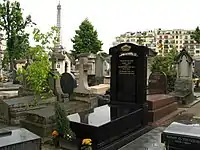
Bảo Đại died in a military hospital in Paris, on 30 July 1997. He was interred in the Cimetière de Passy.
Perception of Bảo Đại in Vietnam
The Communist Party of Vietnam considered him to be a traitor. After he was once again helped by France as the Head of State of Vietnam, Ho Chi Minh said in an interview with Chinese media: "Vĩnh Thụy brought the French invading army back to Vietnam and killed more compatriots. Vĩnh Thụy is a true traitor. The French colonists conspired to restore slavery in Vietnam. Vĩnh Thụy is the confidant of the colonists. Although Vietnamese law is very tolerant to those who have lost their way, they will severely punish the traitorous orphans. The Vietnamese people are determined to defeat all colonial conspiracies and fight for true independence and reunification."[20][21]
Pictures
 Enthronement ceremony of the emperor at the Imperial City, Huế.
Enthronement ceremony of the emperor at the Imperial City, Huế.Agence_Rol_btv1b530824645_1.jpg.webp) Emperor Khải Định, Prince Vĩnh Thụy (middle) and Albert Sarrault in Marseille, 1922.
Emperor Khải Định, Prince Vĩnh Thụy (middle) and Albert Sarrault in Marseille, 1922. The visit of Bảo Đại to the ancestral tombs of Nguyễn Clan in Thanh Hóa, 4/11/1932.
The visit of Bảo Đại to the ancestral tombs of Nguyễn Clan in Thanh Hóa, 4/11/1932.Agence_de_btv1b9052997q.jpg.webp) Abd Al Rahman Barjach Pasha of Rabat, Bảo Đại and prince Vĩnh Cẩn in 1932.
Abd Al Rahman Barjach Pasha of Rabat, Bảo Đại and prince Vĩnh Cẩn in 1932. Emperor in Vietnam after finishing his study in France.
Emperor in Vietnam after finishing his study in France. Bảo Đại riding horse.
Bảo Đại riding horse. Bảo Đại (right) at the tennis court and his cousin Vĩnh Cẩn (left).
Bảo Đại (right) at the tennis court and his cousin Vĩnh Cẩn (left).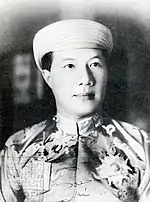
 Emperor in cyclo.
Emperor in cyclo.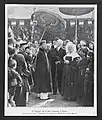 Bảo Đại visits a Catholic church in Hanoi.
Bảo Đại visits a Catholic church in Hanoi. Emperor at ceremony.
Emperor at ceremony.
In popular culture
- Bảo Đại was portrayed by actor Huỳnh Anh Tuấn in the 2004 Vietnamese miniseries Ngọn nến Hoàng cung (A Candle in the Imperial Palace).
- On 13 May 2017, a watch owned by Bảo Đại, a unique Rolex ref. 6062 triple calendar moonphase watch made for him while he was working in Geneva, became one of the most expensive watches ever sold, selling for a then record price of US$5,060,427 at a Phillips auction in Geneva.[22][23]
Bảo Đại coins
The last cash coin ever produced in the world bears the name of Bảo Đại in Chữ Hán. There are three types of this coin. Large cast piece with 10 văn inscription on the reverse, medium cast piece with no reverse inscription, and small struck piece. All were issued in 1933.
 Bảo Đại Thông Bảo 10 văn Paul the Great reign (1925–1945)
Bảo Đại Thông Bảo 10 văn Paul the Great reign (1925–1945) Bảo Đại Thông Bảo plain reverse
Bảo Đại Thông Bảo plain reverse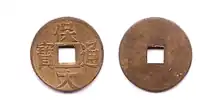 Struck Bảo Đại Thông Bảo
Struck Bảo Đại Thông Bảo
Quotes
- In 1945 when the Japanese colonel in charge of the Hue garrison told Bảo Đại that he had (in line with the orders of the Allied commander) taken measures ensuring the security of the Imperial Palace and those within it against a possible Việt Minh coup, Bảo Đại dismissed the protection declaring "We do not wish a foreign army to spill the blood of our people."[24]
- He explained his abdication in 1945 saying "We would prefer to be a citizen of an independent country rather than Emperor of an enslaved one."[24]
- When, after World War II, France attempted to counter Hồ Chí Minh's popularity and gain the support of the U.S. by creating a puppet government with him, he said "What they call a Bảo Đại solution turns out to be just a French solution."[25]
- In a rare public statement from France in 1972, Bảo Đại appealed to the people of Vietnam for national reconciliation, saying "The time has come to put an end to the fratricidal war and to recover at last peace and accord."[26]
Honours
National honours
- Sovereign and Grand Master of the Imperial Order of the Dragon of Annam.
- Sovereign and Grand Master of the Imperial Order of Merit of Annam (revived and expanded as the National Order of Vietnam on 10 June 1955).
Foreign honours
 Thailand: Knight of the Most Illustrious Order of the Royal House of Chakri (Kingdom of Thailand, 1939).
Thailand: Knight of the Most Illustrious Order of the Royal House of Chakri (Kingdom of Thailand, 1939)..svg.png.webp) France: Knight Grand Cross of the Order of the Legion of Honour (10 September 1932).
France: Knight Grand Cross of the Order of the Legion of Honour (10 September 1932). Cambodia: Knight Grand Cross of the Royal Order of Cambodia.
Cambodia: Knight Grand Cross of the Royal Order of Cambodia..svg.png.webp) Laos: Knight Grand Cross of the Order of the Million Elephants and the White Parasol.
Laos: Knight Grand Cross of the Order of the Million Elephants and the White Parasol..svg.png.webp) Belgium: Knight Grand Cross of the Order of the Crown (1935).
Belgium: Knight Grand Cross of the Order of the Crown (1935). Morocco: Knight Grand Cross of the Sharifian Order of Al-Alaoui (Kingdom of Morocco).
Morocco: Knight Grand Cross of the Sharifian Order of Al-Alaoui (Kingdom of Morocco). Johor: Member First Class of the Royal Family Order of Johor [DKI] (21 March 1933).
Johor: Member First Class of the Royal Family Order of Johor [DKI] (21 March 1933).
Reign symbols
| Symbols created and / or used during the reign of Bảo Đại | ||
|---|---|---|
| Symbol | Image | Description |
| Emperor of the Nguyễn dynasty | ||
| 8 imperial seals created for Emperor Bảo Đại.[27] | .png.webp) | See Seals of the Nguyễn dynasty. |
| Personal standard of emperors Khải Định and Bảo Đại |  | Flag ratio: 2:3. |
| Personal coat of arms of Bảo Đại. | _B%E1%BA%A3o_%C4%90%E1%BA%A1i_(%E4%BF%9D%E5%A4%A7).svg.png.webp) | A sword per fess charged with the ramparts of the Purple Forbidden City in Huế, inscribed with two Traditional Chinese (Hán) characters (保大) and supported by a single dragon. Influences: |
| Bảo Đại Thông Bảo (保大通寶) | _cash_coins_-_Donald_Trung_Quoc_Don_(%E5%BE%B5%E5%9C%8B%E5%96%AE)_01.png.webp) | The last cash coins issued by a government in both Vietnam and the world. |
| Bảo Đại Bảo Giám (保大寳鑑) | _-_Nh%E1%BB%8B_Nghi_(%E4%BA%8C%E5%84%80)_02.png.webp) | A series of silver coins bearing his reign era. |
| Chief of State of Vietnam | ||
| Seal as the chief of state of Vietnam. | .svg.png.webp) | A seal with the inscriptions "Quốc-gia Việt-Nam", "Đức Bảo Đại Quốc-trưởng" written in Latin script and "保大國長" in seal script. |
| Personal standard |  | Flag ratio: 2:3. Influences: |
References
- 1 2 Bao Dai had two sons and three daughters, according to the genealogy of the Nyugen Phuc clan. Only his children by Nam Phuong are listed. His obituary in The Independent says he had two sons and two daughters while the New York Times says two sons and four daughters. (''Nguyễn Phúc tộc thế phả, 1995, p. 330).
- 1 2 Philip Shenon (2 August 1997). "Bao Dai, 83, of Vietnam; Emperor and Bon Vivant". The New York Times. p. 1 10. Retrieved 5 April 2022.
- ↑ Nghia M. Vo Saigon: A History 2011 – Page 277 "Bảo Đại was born in 1913, the 13th and last monarch of the Nguyễn dynasty. He ruled from 1926 to 1944 as emperor of Annam and emperor"
- ↑ Chapman, Jessica M. (September 2006). "Staging democracy: South Vietnam's 1955 referendum to depose Bao Dai". Diplomatic History. 30 (4): 687. doi:10.1111/j.1467-7709.2006.00573.x.
- 1 2 Currey, Cecil B. (2011). Tucker, Spencer C. (ed.). The encyclopedia of the Vietnam War : a political, social, and military history (2nd ed.). Santa Barbara, CA: ABC-CLIO. pp. 94-95. ISBN 9781851099610.
- 1 2 3 Viet, Dan, "vua Bảo Dại co bao nhieu vọ con?," Nghệ Thuật Xưa
- ↑ "'Gái quê' thành vũ nữ đa tình nức tiếng", Người đưa tin, 17 January 2013.
- ↑ McAlister, John T. (1968). Vietnam, the Origins of the Revolution (1885-1946) (PDF). Washington, DC: American University, Center for Research in Social Systems. p. 88.
- ↑ Stanley Karnow, Vietnam: A History p162 "Nothing has reinforced the Vietminh cause more than the mercurial Bao Dai's decision to abdicate. For his gesture conferred the 'mandate of heaven' on Ho, giving him the legitimacy that, in Vietnamese eyes, had traditionally resided in the emperor."
- ↑ David G. Marr Vietnam: State, War, Revolution, 1945–1946 p20 "The royal mandarinal hierarchies for education, administration, and justice were abolished, while Mr. Vĩnh Thụy (formerly Emperor Bảo Đại) was appointed advisor to the DRV provisional government."
- 1 2 3 4 5 6 7 8 9 United States. Department of Defense (1971). The Pentagon papers : the Defense Department history of United States decisionmaking on Vietnam / 1. Vol. 1. Mike Gravel. Boston: Beacon Pr. ISBN 0-8070-0527-4. OCLC 643945604.
- ↑ Interview with Ngô Đình Luyến. WGBH Media Library and Archives. 31 January 1979.
- 1 2 Direct Democracy
- ↑ oral communication (Patrick-Edward Bloch-Carcenac) and sections of the "Dernières Nouvelles d'Alsace" (D.N.A), n°. 264 of 10 November 1992 and from 7 August 2007.
- ↑ "RENAISSANCE DE HUE – Site de maguy tran – pinterville" (in French). Archived from the original on 20 March 2015.
- ↑ Pearson, Richard (2 August 1997). "BAO DAI, FORMER EMPEROR OF VIETNAM, DIES". Washington Post. ISSN 0190-8286. Retrieved 8 January 2024.
During his years in French exile, Bao Dai converted from Buddhism to Roman Catholicism and lost the greater part of his fortune.
- ↑ de Rochebouët, Béatrice (28 October 2022). "Enchères: sous le sceau du dernier empereur du Vietnam" [Auction: under the seal of the last emperor of Vietnam]. Le Figaro (in French). Archived from the original on 23 August 2023. Retrieved 8 January 2024.
Et, sur son initiative, reçut en 1988 le baptême catholique.
[And, on his initiative, he received Catholic baptism in 1988.]{{cite news}}:|archive-date=/|archive-url=timestamp mismatch; 25 August 2023 suggested (help) - ↑ "BẢO ĐẠI (NGUYỄN PHÚC VĨNH THỤY, JEAN-ROBERT, 1913–1997)". indochine.uqam.ca. University of Quebec in Montreal. Retrieved 8 January 2024.
The former emperor died there, after having remarried a French woman in 1972 and converted to Catholicism in 1988.
{{cite web}}: CS1 maint: url-status (link) - ↑ D. Fineman (1997). A Special Relationship: The United States and Military Government in Thailand, 1947–1958. University of Hawaii Press. p. 111. ISBN 9780824818180.
- ↑ Những cuộc trả lời phỏng vấn báo chí của Bác Hồ (Phần 4), Trang tin điện tử Ban Quản lý Lăng Chủ tịch Hồ Chí Minh.
- ↑ Trả lời điện phỏng vấn của Dân quốc nhật báo (1949)(1), Hồ Chí Minh toàn tập, Tập 5 (1947–1949), Nhà Xuất bản Sự thật, Hà Nội, 1985, trang 211, 212.
- ↑ "ROLEX Ref. 6062". Philipps.
- ↑ Naas, Roberta. "Bao Dai Rolex Sells For More Than $5 Million At Phillips Auction, Setting A New World Record". Forbes. Retrieved 23 November 2018.
- 1 2 D. G. Marr (1997). Vietnam 1945: The Quest for Power. London, England: University of California Press. ISBN 9780520212282.
- ↑ H. R. McMaster (1998). Dereliction of Duty: Johnson, McNamara, the Joint Chiefs of Staff, and the Lies That Led to Vietnam. New York, NY: HarperCollins. ISBN 9780060929084.
- ↑ P. Shenon (2 August 1997). "Bao Dai, 83, of Vietnam; Emperor and Bon Vivant". The New York Times.
- ↑ VietNamNet Bridge (10 February 2016). "No royal seal left in Hue today. VietNamNet Bridge – It is a great regret that none of more than 100 seals of the Nguyen emperors are in Hue City today". VietNam Breaking News. Archived from the original on 16 July 2022. Retrieved 8 March 2021.
Further reading
- Anh, Nguyên Thê. "The Vietnamese Monarchy under French Colonial Rule 1884–1945." Modern Asian Studies 19.1 (1985): 147–162 online.
- Chapuis, Oscar. The Last Emperors of Vietnam: From Tu Duc to Bao Dai (Greenwood, 2000).
- Chapman, Jessica M. "Staging democracy: South Vietnam's 1955 referendum to depose Bao Dai." Diplomatic History 30.4 (2006): 671–703. online
- Hammer, Ellen J. "The Bao Dai Experiment." Pacific Affairs 23.1 (1950): 46–58. online
- Hess, Gary R. "The first American commitment in Indochina: The acceptance of the 'Bao Dai solution', 1950." Diplomatic History 2.4 (1978): 331–350. online
- Lockhart. Bruce McFarland (1993). The End of the Vietnamese Monarchy. Lac Viet Series. Vol. 15. New Haven, CT: Yale Center for International and Area Studies. ISBN 9780938692508.
- Szalontai, Balázs. "The 'Sole Legal Government of Vietnam': The Bao Dai Factor and Soviet Attitudes toward Vietnam, 1947–1950." Journal of Cold War Studies (2018) 20#3 pp 3–56. online
Other languages
- Bảo Đại's memoirs have been published in French and in Vietnamese; the Vietnamese version appears considerably longer.
- Bảo Đại (1980). Le dragon d'Annam (in French). Paris: Plon. ISBN 9782259005210.
- Bảo Đại (1990). Con rong Viet Nam: hoi ky chanh tri 1913–1987 (in Vietnamese). Los Alamitos, CA: Nguyen Phuoc Toc (distributed by Xuan Thu Publishing). OCLC 22628825.
External links
- Newspaper clippings about Bảo Đại in the 20th Century Press Archives of the ZBW


_colour_scheme_-_%C4%90%E1%BA%A1i_Nam_(%E5%A4%A7%E5%8D%97).svg.png.webp)
.svg.png.webp)